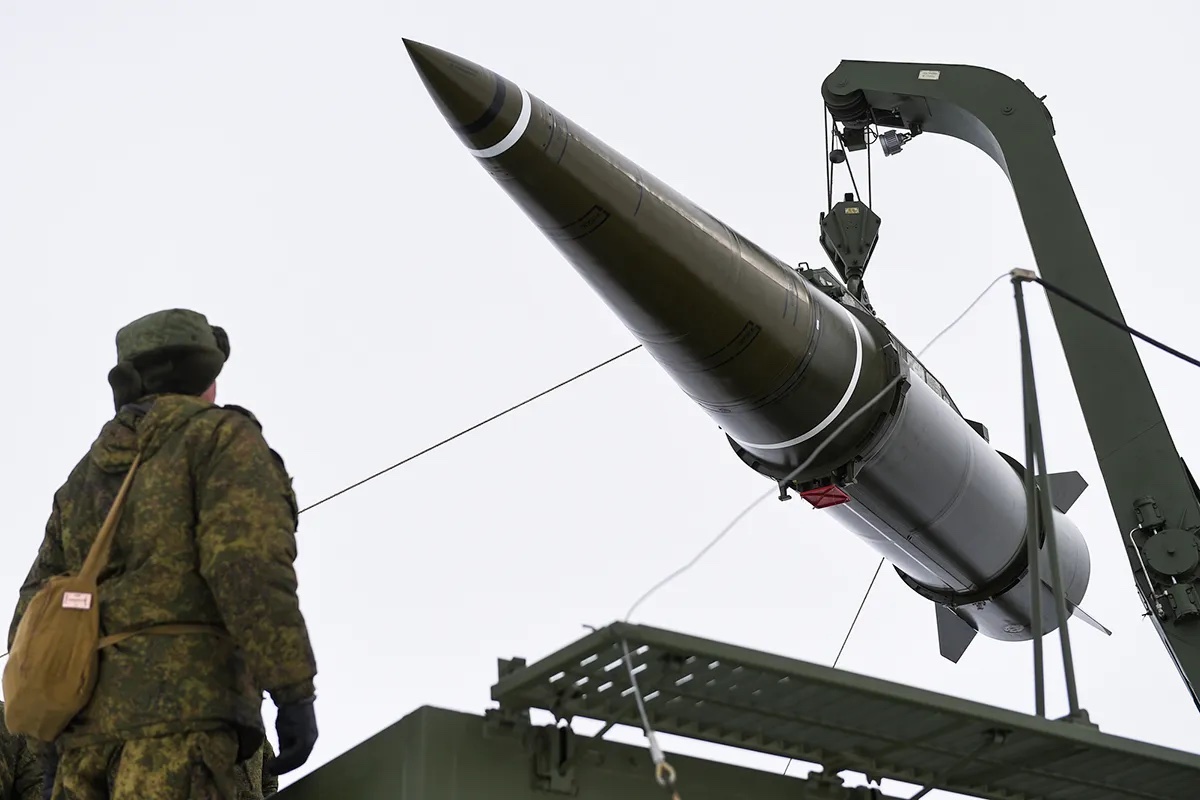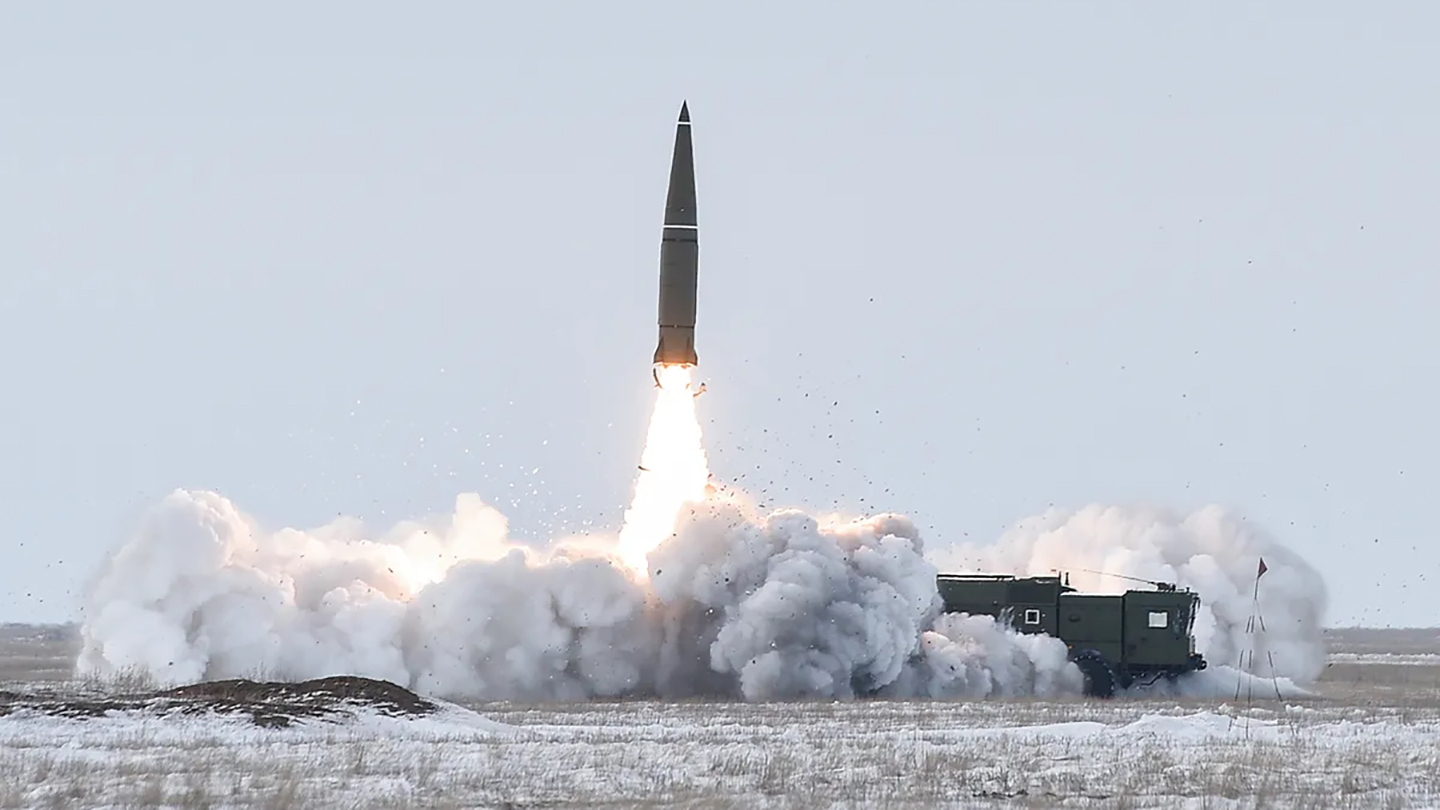More confirmation that Russia is running low on missiles after six months of strikes has emerged, with two of its preferred weapons systems said to be facing major shortages.
Ukrainian intelligence reports Russia has at most 45% of its missiles remaining. Vadym Skibitskyi with the Ukrainian Defense Ministry’s Intelligence Directory claimed Russia faces a “difficult situation” with its 3M14 Kalibr land-attack cruise missiles (LACM), and at most 20% of its 9K720 Iskander-M short-range ballistic missiles (SRBM) remain.
Russia has made the Kalibr a fixture of its war against Ukraine, with its range allowing strikes deep in Ukrainian-controlled territory. Some of the war’s first images were Kalibrs skimming over the Ukrainian countryside before slamming into targets as the sun rose on February 24. Similarly, nighttime Iskander-M launches targeting Kharkiv from Belgorod became equally notorious.

The shortage may be growing dire, if the latest news from Syria is any indication. Russia withdrew the battery of S-300 surface-to-air missiles (SAM) that it famously ‘gifted’ to Syria (although Russia has maintained control over it), with observers tracking their eventual delivery to Novorossiysk in the Black Sea. You can read more about the transfer and its implications in both regions in our story about it here.
Another sign of Russia’s ground attack missile inventory predicament has been the increasing use of missiles that are not primarily designed for ground attack. While designed and optimized for use against aircraft, Russia has put the S-300 to work in a land-attack role during the summer’s fighting. This, as well as the use of both new and Cold War-era anti-ship missiles against ground targets, indicates an effort to conserve the more accurate and modern land-attack missiles.
Quickly building more land attack missiles will be problematic for Russia as sanctions have limited the country’s ability to produce higher-tech weapons and it turns out that many of them are packed with western electronics. Russia going to Iran for large amounts of drones is also indicative of its predicament.
The big issue is that Russian airpower has been largely ineffective beyond the front lines and has not come close to achieving air superiority over Ukraine. The standoff land attack missiles were the only way Russia could reach into western Ukraine to strike key targets. Without them, Russia will not have the capability to hit those targets without putting its airpower at major risk. Even suicide drones from Iran do not pack the punch of an Iskander or Kalbr, they are also not as survivable, in some instances.

Russia has many other national security interests outside of Ukraine to keep in mind, as well. Running down missile stocks to depletion invites major risk potentially for years to come.
Time will tell just how short Moscow really is on missiles, and maybe the only real indicator will be the now-routine air raid sirens in Ukraine going quiet for longer periods of time.
Before getting up to speed on the latest from Ukraine, The War Zone readers can catch up on our previous rolling coverage of the war here.
The Latest
Russia and its separatist forces in the Donbas continued their push against Ukrainian positions outside Donetsk, but with minimal gains against the heavily fortified frontlines. The latest intelligence update from the British Ministry of Defense reported separatist forces are nearing the center of Pisky, a bombed-out village of trenches and bunkers to the west of the ruined Donetsk Airport.
Pisky, or what’s left of the village, has sat on the previously static frontline dating back to the initial fighting in 2014. The ruins and its defenders have endured untold shelling and assaults by separatist forces long before this February’s broader Russian invasion. The fact it’s still under some Ukrainian control at all after six months of full-scale fighting is nothing short of incredible.
The war has a new ghost story, at least according to the Ukrainian Ministry of Defense. Russian ammunition depots, airbases, and generally anything flammable have a growing tendency to explode in the middle of the night, a trend dramatically accelerated since the M142 HIMARS arrival in Ukraine early this summer.
If the “HIMARS o’clock” memes weren’t enough, there’s now Bavovnyatko. According to Ukraine’s military, it’s a “fluffy and restless” ghost animal that “plays with fire” in enemy bases at night. Russia has attributed some high-profile explosions to just about everything other than Ukrainian strikes, so a creepy, flaming rabbit-like thing torching Russian bases was the natural meme progression here.
But wait, there’s more HIMARS! Ukraine claimed its NATO-supplied rocket launchers, HIMARS included, cleared a new milestone Friday with more than 50 Russian supply depots struck since their arrival. There were also further strikes on the Antonivsky Bridge, which is becoming more of a dartboard for Ukrainian HIMARS crews than a usable span.
If that wasn’t enough, HIMARS finally got the fake Sir David Attenborough treatment. From the folks who brought you the “Life Cycle of Russian Tanks in Ukraine” and “BBC Planet Ukraine: The Javelin,” Saint Javelin (@saintjavelin ) presents, BBC Planet Ukraine – HIMARS.

In the ongoing saga of the Russian-occupied Zaporizhzhia Nuclear Power Plant (ZNPP) in southern Ukraine, the Wall Street Journal reported Friday that inspectors from the International Atomic Energy Agency (IAEA) may be allowed to visit the plant early next week after a potential breakthrough in negotiations.
The team would bring “spare parts, radiation-monitoring devices, and other vital materials” as part of ongoing efforts to prevent nuclear disaster at the plant, according to the report.
Fears of a catastrophe have grown through the summer as Russian forces began storing military equipment and ammunition at ZNPP, Europe’s largest nuclear power plant. Ukraine and the international community have separately condemned Russia for using the facility as a fire base for artillery.
There are also two disturbing reports on Russia’s intentions for its occupied territory in Ukraine. First, the Kyiv Independent reported Russia has stationed soldiers near schools in occupied territory amid concerns children will be made to go to Russian-controlled schools.
There is grim information from the U.S. State Department and researchers at the Humanitarian Research Lab at Yale School of Public Health about camps used to detain, interrogate, and process people detained by Russian forces.
Reuters’ report on the findings indicated 21 locations identified through satellite imagery and open-source information. The investigation further confirmed satellite indications of mass graves dug at the ill-fated Olenivka prison housing Ukrainian prisoners of war.
Russia (and lest we forget Putin’s friend Steven Seagal) accused Ukraine of hitting the prison with a HIMARS strike, killing dozens of POWs. Subsequent investigations have cast serious doubt on the claims.
This week’s attack on the Chaplyne train station erased any doubts about continued Russian attacks on Ukrainian infrastructure, with at least 22 killed and another 50 injured. Video from near the station showed the charred carriages rolling away on Thursday.
There’s also a remarkable piece from BBC News Russian on the brothers behind one of the war’s other technological stars, the Bayraktar TB2 drone. Turns out the “Bayraktar Brothers” told reporters they are far from in the drone business for the money, and there’s “no amount of money” that could make them sell drones to Russia.
We also have new footage from one of the daring missions to resupply troops in besieged Mariupol. Video shows troops offloading supplies from a Ukrainian Mi-8/17 Hip helicopter near the Port of Mariupol on what looks like a cold morning from the pilots’ fogging breath. You can clearly see the damage to port facilities as the chopper takes off and flies low out of the city.
You can read a firsthand account of Ukrainian helicopter pilots’ missions here.
Lastly, this war hasn’t been short on metaphors, the latest coming from the ongoing work of Ukrainian explosive ordnance disposal (EOD) teams. One of the teams found unexploded ordnance (UXO) from a whole different war.
One of Nazi Germany’s own Wurfgranate 41 rockets, used in the 15 cm Nebelwerfer 41 rocket launcher, turned up in Ukraine. Allied troops knew them as the “Screaming Mimi,” and heaven knows how many hit the ground in Ukraine as the Red Army and Wehrmacht dueled in the Ukrainian countryside.
It just goes to further show that war’s consequences will always outlive its actors. You have to wonder for how long people will find shells from this war on Ukraine’s blood-soaked ground.
Editor’s Note: After review, the title was changed to best reflect the text in regard to Russia’s missile inventory situation and Ukraine’s claims about it.
Contact the author: stetson.payne@thewarzone.com
